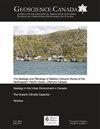Igneous Rock Associations 25. Pre-Pliocene Andean Magmatism in Chile
IF 0.8
4区 地球科学
Q3 GEOSCIENCES, MULTIDISCIPLINARY
引用次数: 2
Abstract
Andean-type magmatism and the term ‘andesite’ are often used as the norm for the results of subduction of oceanic lithosphere under a continent, and the typical rock formed. Although the Andes chain occupies the whole western margin of South America, the most comprehensively studied rocks occur in the present-day Chilean territory and are the focus of this paper. Andean magmatism in this region developed from the Rhaetian-Hettangian boundary (ca. 200 Ma) to the present and represents the activity of a long-lived continental magmatic arc. This paper discusses Pre-Pleistocene volcanic, plutonic, and volcano-sedimentary rocks related to the arc that cover most of the continental mass of Chile (between the Pacific coast and the High Andes) between the latitudes of 18° and 50°S. They comprise most of the range of sub-alkaline igneous rocks, from gabbro to monzogranite and from basalt to rhyolite, but are dominated by the tonalite-granodiorite and andesite example members. Variations in the petrographic characteristics, major and trace element composition and isotopic signature of the igneous rocks can be correlated to changes in the physical parameters of the subduction zone, such as dip angle of the subducting slab, convergence rate and angle of convergence. Early Andean magmatic products (Jurassic to Early Cretaceous) are found along the Coastal Cordillera in the westernmost part of the Andes. The rock record of the subsequent stages (Late Cretaceous, Paleocene–Early Eocene, Middle Eocene–Oligocene, Miocene) is progressively shifted to the east, reflecting migration of the magmatic front towards the continent. Tectonic segmentation of the convergent margin, as attested by the magmatic record, may have occurred throughout the Andean life span but it is particularly evident from the Eocene onwards, where the evolution of the northern part of the Chilean Andes (north of 27°S latitude) is very different to that of the southern segment (south of 27°S latitude). RÉSUMÉLe magmatisme de type andin et le terme « andésite » sont souvent les appellations utilisées pour décrire les résultats de la subduction de la lithosphère océanique sous un continent, et la roche typique formée. Bien que la chaîne des Andes occupe toute la marge ouest de l'Amérique du Sud, les roches les plus étudiées se trouvent dans le territoire chilien actuel et sont l'objet de cet article. Le magmatisme andin dans cette région s'est développé depuis la limite rhéto-hettangienne (environ 200 Ma) jusqu'à aujourd'hui et représente l'activité d'un arc magmatique continental persistant. Cet article a pour sujet les roches volcaniques, plutoniques et volcano-sédimentaires du pré-Pléistocène liées à l'arc qui couvrent la majeure partie de la masse continentale du Chili (entre la côte du Pacifique et les Hautes Andes) entre les latitudes de 18° et 50°S. Elles comprennent la majeure partie de la gamme de roches ignées sous-alcalines, du gabbro à la monzogranite et du basalte à la rhyolite, mais sont dominées par des roches de type tonalite-granodiorite et andésite. Les variations des caractéristiques pétrographiques, de la composition des éléments majeurs et traces et de la signature isotopique des roches ignées peuvent être corrélées aux changements des paramètres physiques de la zone de subduction, tels que l'angle de pendage de la plaque plongeante, le taux de convergence et l'angle de convergence. Les premiers produits magmatiques andins (du Jurassique au Crétacé inférieur) se trouvent le long de la Cordillère de la Côte dans la partie la plus occidentale des Andes. La succession de roche des stades suivants (Crétacé supérieur, Paléocène – Éocène inférieur, Éocène moyen – Oligocène, Miocène) est progressivement déplacée vers l'est, reflétant la migration du front magmatique vers le continent. La segmentation tectonique de la marge convergente, comme l'attestent les enregistrements magmatiques, peut avoir eu lieu tout au long de la formation des Andes, mais elle est particulièrement évidente à partir de l'Éocène, où l'évolution de la partie septentrionale des Andes chiliennes (au nord de 27°S de latitude) est très différente de celle du segment méridional (sud de 27°S de latitude).火成岩协会智利前上新世安第斯岩浆活动
安第斯型岩浆作用和“安山岩”一词经常被用作大陆下海洋岩石圈俯冲的结果,并形成典型的岩石。虽然安第斯山脉占据了南美洲的整个西部边缘,但研究最全面的岩石出现在今天的智利境内,也是本文的重点。该地区的安第斯岩浆活动从雷蒂安-赫唐安界线(约200 Ma)发展至今,代表了一个长期存在的大陆岩浆弧的活动。本文讨论了覆盖智利大部分大陆块(位于太平洋海岸和安第斯山脉之间),纬度在18°到50°之间的弧相关的前更新世火山岩、深成岩和火山沉积岩。它们包括从辉长岩到二长花岗岩,从玄武岩到流纹岩的大部分亚碱性火成岩,但以辉长岩-花岗闪长岩和安山岩样品成员为主。火成岩的岩相特征、主微量元素组成及同位素特征的变化,可与俯冲板块倾角、收敛速度、收敛角等俯冲带物性参数的变化联系起来。早安第斯岩浆岩产物(侏罗纪至早白垩世)分布在安第斯山脉最西端的海岸科迪勒拉。晚白垩世、古新世—早始新世、中始新世—渐新世、中新世的岩石记录逐渐东移,反映了岩浆锋向大陆的迁移。岩浆记录证明,汇聚边缘的构造分割可能贯穿安第斯山脉的整个生命周期,但始新世以后尤其明显,智利安第斯山脉北部(南纬27°以北)的演化与南部(南纬27°以南)的演化非常不同。RESUMELe magmatisme de类型,只有等le terme«安山岩»是可是les称谓使用倒描写les预见结果de la俯冲de la岩石圈oceanique苏联合国大陆,等拉罗氏把formee。安第斯山脉附近的地区占南部地区的大部分地区,南部地区的地区占南部地区的大部分地区,南部地区的地区占南部地区的大部分地区,南部地区的地区占南部地区的大部分地区。Le magmagatisme和in dans都认为, magmagatisme与 magmagei(2000年前后)的差别是: magmagei与 magmagei的差别是: magmagei与 magmagei的差别。第a条规定:火山岩、火山岩和火山- - - - - - - - - - - - - - - - - - - - - - - - - - - - - - - - - - - - - - - - - - - - - - - - - - - - - - - - - - - - - - - - - - - - - - - - - - - - - - - - - - - - - - - - - - - - - - - - - - - - - - - - - - - - - - - - - - - - - - - - - - - - - - - - - - - - - - - - - - - - - - - - - - - - - -不可抗拒的是,辉长岩-二长花岗岩-玄武岩-流纹岩,主要是不可抗拒的是,辉长岩-花岗闪长岩-黄铁矿-黄铜矿。“变异体”、“变异体”、“变异体”、“变异体”、“变异体”、“变异体”、“变异体”、“变异体”、“变异体”、“变异体”等。Les premiers产品magmatiques和ins (du Jurassique au crcrassacac infacrieur)在la cordillires de la Côte和la party la la和occidentale des Andes之间进行。La继承de罗氏des施塔德按照(Cretace特级,古新世-始新世inferieur,平均始新世-渐新世、中新世)est progressivement deplacee更l是refletant杜拉迁移前magmatique更小的大陆。大型汇聚的分段构造,岩浆登记的证明,安第斯山脉形成的长期记录,主要是关于特定的 纵向纵向的 纵向纵向的, où安第斯山脉儿童的纵向纵向的(南纬27°以北)和纵向纵向的横向的(南纬27°以南)。
本文章由计算机程序翻译,如有差异,请以英文原文为准。
求助全文
约1分钟内获得全文
求助全文
来源期刊

Geoscience Canada
地学-地球科学综合
CiteScore
3.30
自引率
0.00%
发文量
9
审稿时长
>12 weeks
期刊介绍:
Established in 1974, Geoscience Canada is the main technical publication of the Geological Association of Canada (GAC). We are a quarterly journal that emphasizes diversity of material, and also the presentation of informative technical articles that can be understood not only by specialist research workers, but by non-specialists in other branches of the Earth Sciences. We aim to be a journal that you want to read, and which will leave you better informed, rather than more confused.
 求助内容:
求助内容: 应助结果提醒方式:
应助结果提醒方式:


